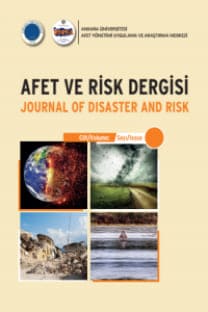Guba-Khachmaz (Azerbaycan Cumhuriyeti Kuzey-Doğu Bölgesi) İktisadi-Coğrafi Bölgesindeki Yerleşimlerden Evlilik ve Boşanma Dinamikleri
Bu çalışma da 2001-2015 yıllarında Guba-Khachmaz ekonomik-coğrafi bölgesi ve ayrı idari ilçelerinin kentsel-kırsal nüfuslarındaki evlilik ve boşanma sayıları ile 2000-2019 ekonomik-coğrafi bölgelerdeki evlilik ve boşanma sayıları gözden geçirilmiştir. 1995-2019 döneminde ekonomik-coğrafi bölgede kentsel ve kırsal yerleşim alanlarındaki evlilik ve boşanma programları derlenmiş ve incelenmiştir. Ayrıca 2019 yılı evlilik ve boşanma oranları haritalama tekniği kullanılarak ele alınmıştır. Evlilik ve boşanma oranları ile ilgili bilgiler özet olarak tablolar kullanılarak gösterilmiştir.Yapılan gözden geçirme çalışması sonucunda, düşük sosyo-ekonomik yaşam koşullarının kentsel ve kırsal alanlarda yaşayan sağlıklı nüfusun bölgelere ve yabancı ülkelere göç etmesine neden olduğu söylenebilir. Bu göç hareketleri aynı zamanda yerleşim yerlerinde yaşayan nüfusun demografik göstergeleri üzerinde de olumsuz bir etki oluşturmuştur. Nitekim bölgedeki evlilik sayısının azalmış olduğu ve boşanma oranının arttığı bulgulanmıştır. Bunun yanı sıra göç veren bölgelerin sosyo-ekonomik kalkınmasıyla ilgili olarak devlet programları kapsamında, ekonomik ve coğrafi alanda nüfusun yaşam koşullarını iyileştirmek için yeni iş alanlarının oluşturulduğu bulgulanmıştır. Bununla beraber işgücü kaynaklarının bu şekilde istihdamı ve doğal nüfus artışındaki artış demografik büyümeyi olumlu etkilerken yine de yeterli olmadığı düşünülmektedir.
Dynamics of Marriages and Divorces by Settlements in the Economic -Geographic Region of Guba - Khachmaz (North-East Area of Azerbaijan Republic)
In this study, the number of marriages and divorces in the urban-rural populations of the Guba-Khachmaz economic-geographical region and separate administrative districts in 2001-2015 and the number of marriages and divorces in the economic-geographical regions of 2000-2019 were reviewed. Marriage and divorce programs in urban and rural settlements in the economic-geographical region between 1995 and 2019 were compiled and analyzed. In addition, 2019 marriage and divorce rates were handled using the mapping technique. Information on marriage and divorce rates are summarized using tables.As a result of the review study, it can be said that low socio-economic living conditions cause healthy population living in urban and rural areas to migrate to regions and foreign countries. These migration movements also had a negative impact on the demographic indicators of the population living in settlements. As a result, it has been found that the number of marriages in the region has decreased and the divorce rate has increased. In addition, it has been found that new business areas have been created in order to improve the living conditions of the population in the economic and geographical area within the scope of state programs regarding the socio-economic development of the regions that emigrate. However, while this employment of labor resources and the increase in natural population growth affect demographic growth positively, it is still considered to be insufficient.
Keywords:
Divorces, Marriages, Region Settlements,
___
- Barantseva, Natalia A., (2018). Dynamics of marriage-family relations of the population of the south of Krasnoyarsk Kara in the late 1940s-1980s. Toms State University Journal, 428(3), 54-63.
- Bitler, M. P., Gelbach, J. B., Hilary W. Hoynes, H. W., Zavodny M., (2004). The Impact of Welfare Reform on Marriage and Divorce. Journal of Demography, 41(2), 213-236.
- Bruce Phillips, B., Griffiths, W., (2004). Female Earnings and Divorce Rates: Some Australian Evidence. Australian Economic Review, 37(2), 139-152.
- Eminov Z.N. (2005). The population of Azerbaijan. Baku: Chiraq.
- Eminov Z.N. (2007). Demographic bases of family-marriage relations in Daglig-Shirvan economic-geographical region. Works of the Azerbaijan Geographical Society. (pp. 310-315). Mountain geosystems of Azerbaijan; problems and perspectives, Baku.
- Eminov Z.N. (2016). The dynamics of marriages and divorce in the Republic of Azerbaijan. Azerbaijan National Academy of Science Institute of Geography named after academic H.A.Aliyev. (pp. 77-83). Problems of population and demographic development in the Sheki-Zagatala economic-geographical region, Baku.
- Gonzales-Val, R., Marcén, M., (2018). Unemployment, Marriage and Divorce. Applied Economics, 50(13), 1495-1508, https://www.tandfonline.com/doi/abs/10.1080/00036846.2017.1366642?journalCode=raec20.
- Rasul I., (2005). Marriage Markets and Divorce Laws. Journal of Law, Economics and Organization, 22(1), 30-69. Regional analysis of demographic processes in the Republic of Azerbaijan. (2003). (pp. 27-44).
- Roy, S., (2011). Unemployment Rate and Divorce, https://onlinelibrary.wiley.com/doi/abs/10.1111/j.1475-4932.2011.00746.x.
- Stevenson B., (2006). The Impact of Divorce Laws on Marriage-Specific Capital. Journal of Labor Economics, 25(1), 75-94.
- Stevenson, B., Wolfers, J., (2007). Marriage and Divorce: Changes and their driving forces. Journal of Economic Perspectives, 21(2), 27-52.
- The State Statistical Committee of the Republic of Azerbaijan. (2020). (pp. 364-445). Demographic Indicators of Azerbaijan (p. 532).
- The State Statistical Committee of the Republic of Azerbaijan. The number of natural increase, birth and death of Azerbaijan Republic by urban and districts for 1990-2019 years. Retrieved from Jule 7, 2020. https://www.stat.gov.az/source/demoqraphy/
- Wolfe, B. L., (2008). Divorce and Divorce Reform: A reconciliation of results at odds. Retrieved from https://www.researchgate.net/publication/266268483_Divorce_and_Divorce Reform A reconciliation of_results_at_odds.
- Yayın Aralığı: Yılda 4 Sayı
- Başlangıç: 2018
- Yayıncı: Ankara Üniversitesi
Sayıdaki Diğer Makaleler
Taşkın Risk Haritasının Oluşturulması: Trabzon İli Vakfıkebir İlçesi Kirazlı Deresi Örneği
Esra ERTÜRK, Nihat KAYA, Selçuk MERCAN
Bütünleşik Afet Riski Azaltımı ve İklim Değişikliğine Uyum Yaklaşımı Üzerine Bir Değerlendirme
Erzurum İli Doğa Olayları Profili ve Deprem Tehlikesi
Turabi KARADAĞ, Habip DAYIOĞLU
İstanbul’u Büyük Bir Deprem Bekliyor: Mini Derleme
